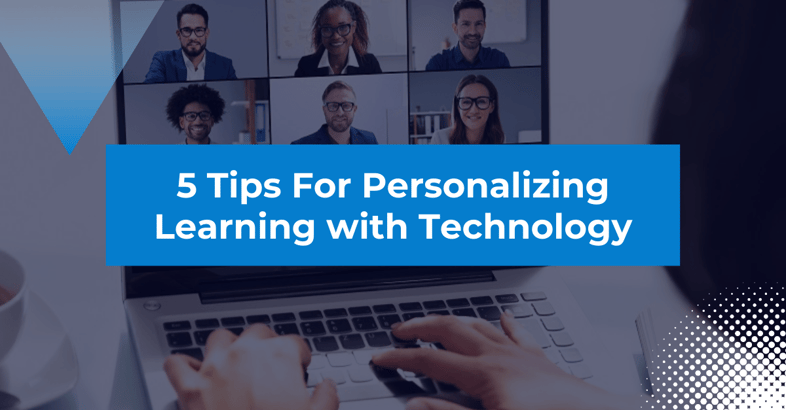5 Tips for Personalizing Learning with Technology
By Admin
The last decade has witnessed something of a revolution in the Edtech (educational technology) industry, with large businesses and exciting new startups venturing into the personalized learning sector. In all aspects of life, consumers have come to expect and pursue new levels of personalization, whether it be shopping, entertainment, or food. With this modern approach to learning comes new challenges, new evolutions, and new methodologies.
Read on as we seek to provide 5 tips for personalizing learning with technology and deriving the best results for your learning journeys.
Embrace the scalability
For both teachers and students, one of the crucial factors of educational technology is the scalability and diversity of an application. Teachers are aware that one of their biggest hurdles is reaching their students as individual learners and not teaching a copy & paste course to each student. Students, of course, want to be treated and taught as individuals and feel that there is a bespoke element to their learning. With the right technology, teachers can find solutions for this problem and scale personalized lessons and teaching to their students.
The first task is to understand the different individual needs, challenges, and preferences of each student. Next is actually personalising a course to potentially hundreds of students, which is beyond the realm of possibility for most, without the aid of technology. This is because technology doesn’t fatigue or lose track of progress, it remains alert and continues capturing the relevant data points. A human teacher can’t better this ability, but they can utilise it to their advantage. Teachers must find tools, such as simulations, that aid their efforts and scale them across their entire student network, if not for the benefit of their students, but for the sake of their own time saved during lesson planning and progress tracking. Much of the administrative side of teaching can be automated and computerized, allowing teachers to redistribute their time and energy to the aspects of teaching that they are best at.
Use crucial data and information to inform decisions
The technology that teachers have sought for years, allowing them to personalize materials, progress, and learning journeys, now exists. This technology is full of useful data that can influence challenges and interventions, build on strengths, and tackle weaknesses. All it requires is the teacher to embrace and start using it.
If a teacher can cross-reference certain skills with performance indicators across each class, they can gain insight into who needs help, who might drop out, and who could benefit from a different type of challenge. If a sub-section of students is noticed to be lacking the same set of skills or knowledge, that can be addressed using technology. Study habits can be changed. Reading materials can be distributed. Tasks can be set. Technology enables these things. It also allows students who are already well-versed in certain aspects of a course to avoid repeating learning things that they already know, thus reducing their workload and refocusing their time appropriately.
Of course, it’s not only teachers who can embrace data. Most students are equipped with smartphones, tablets, and laptops, which can utilize the technologies that track their learning and help inform their studies. Personalization from these devices can be incredibly accurate, responsive, and supportive, especially from Edtech companies who study the impact of their tools.
More ideas, more technology, more experiences
The vast amount of technological experiences in the field of education that one can have is immense. The marketplace is a thriving, bustling space with different techniques, concepts, and considerations, for almost any field of study. When new tools enter the market, teachers must try them out. They must begin to dedicate a small part of their time towards testing new tools. What works for one lecturer might not work for another. What works for one module of a degree might flatline on another, which should give lecturers the knowledge that flexibility is fundamental when approaching these varying technologies.
Different user experiences, different interfaces, different connectivity to mobile devices, different messaging houses, and more can all seriously impact how well a tool is received by teachers and students alike. Interestingly, a failed technological experience is a learning experience in itself.
At the front end, there are different learning environments for different subjects. Within these environments, you have different methods of customising content, different options for delivery, and the tracking of different analytics to study engagement and behavior. You have embedded simulations, games, videos, quizzes, messaging systems and more, meaning each learner can find opportunities to learn the same material in a different learning style. The key here for learners and educators is to take a trial and error approach.
One methodology which is proven to be effective in a high percentage of classrooms and scenarios is business simulations. When it comes to teaching strategy, innovation, and teamwork, simulations can help students to excel and step into real-life business scenarios. See why world-renowned academic institutions swear by them.
Greater levels of student engagement
Anyone who has been through the experience of academia can relate to the notion that there is sometimes a disconnect between students and teachers, whether that be language, teaching style, or the use of technology. There is also the disconnect between teachers and other teachers, whose styles differ so vastly that students feel they might be doing things wrong in each class. As well as this, there’s the disconnect between students and other students who are at different levels or varying stages along the course. Educational technology can sure up all of these consistencies and reconnect everybody, engaging them in the content on offer.
With the benefits of personalization, students’ needs, abilities, and aims can be taken into account and used to drive the course, allowing for greater growth and engagement. So, what might this actually look like?
- Instruction and lessons taught in the form of exciting business simulations, videos, games, quizzes, and more
- Better ways of testing skills other than tests and essays, for example, multimedia presentations, creative projects, animations, and more
- Digital tools can track performance, collect feedback, and use the information to follow up in the future with greater levels of personalization
All of these features will keep students switched on.
New approaches to testing and homework
Students wait anxiously over days and weeks to find out the mark or score they receive on a test. When that test comes back, they may have failed a whole section or concept. Downhearted, they suck it up and move along, without addressing the issue. Well, not anymore, thanks to new Edtech software, teachers can see answers immediately and can grade tests with the aid of a computer assistant. The teacher can see where students are struggling, diagnose the problem, and form a solution in future lessons.
As well as testing at the end of modules, Edtech presents a chance to test knowledge at the start of a module and use that assessment as the basis of the course content and structure. Of course, personalization works best at the start, not at the end, so this is a great tip for any teachers.
Conclusion
There you have it, 5 tips for personalizing learning with technology. Just to recap:
- Find scalable tech models that suit your classroom needs
- Use data and analytics to inform lessons and testing
- Try many tools, not just the most popular ones
- Drive student engagement through technology, especially simulations
- Try different styles of testing and pre-testing to maximize personalization


.png?width=352&name=Blog%20Raw%20Images%20(1).png)

.png?width=352&name=Blog%20Image%20Template%20UPDATED%20(12).png)